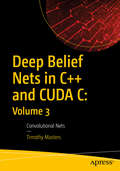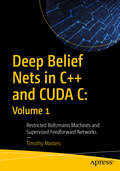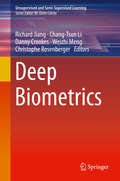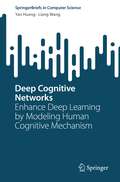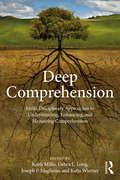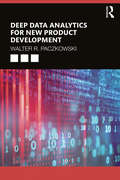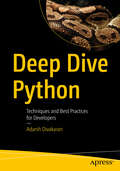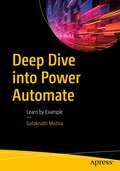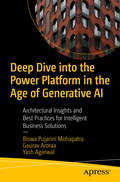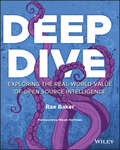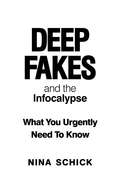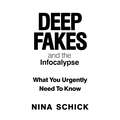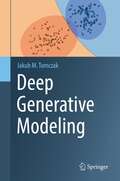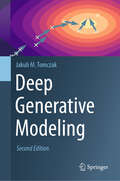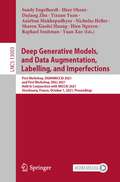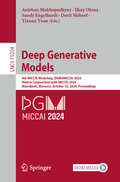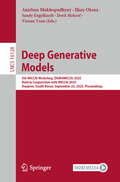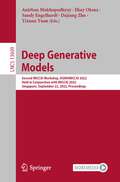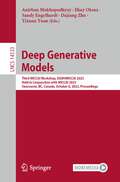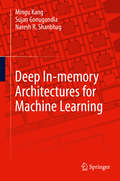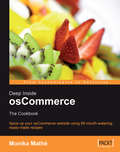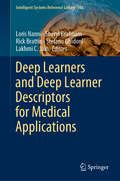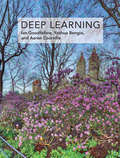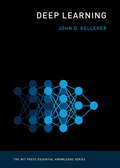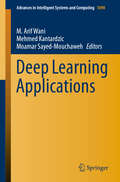- Table View
- List View
Deep Belief Nets in C++ and CUDA C: Convolutional Nets
by Timothy MastersDiscover the essential building blocks of a common and powerful form of deep belief network: convolutional nets. This book shows you how the structure of these elegant models is much closer to that of human brains than traditional neural networks; they have a ‘thought process’ that is capable of learning abstract concepts built from simpler primitives. These models are especially useful for image processing applications. At each step Deep Belief Nets in C++ and CUDA C: Volume 3 presents intuitive motivation, a summary of the most important equations relevant to the topic, and concludes with highly commented code for threaded computation on modern CPUs as well as massive parallel processing on computers with CUDA-capable video display cards. Source code for all routines presented in the book, and the executable CONVNET program which implements these algorithms, are available for free download.What You Will LearnDiscover convolutional nets and how to use themBuild deep feedforward nets using locally connected layers, pooling layers, and softmax outputsMaster the various programming algorithms requiredCarry out multi-threaded gradient computations and memory allocations for this threadingWork with CUDA code implementations of all core computations, including layer activations and gradient calculationsMake use of the CONVNET program and manual to explore convolutional nets and case studiesWho This Book Is ForThose who have at least a basic knowledge of neural networks and some prior programming experience, although some C++ and CUDA C is recommended.
Deep Belief Nets in C++ and CUDA C: Restricted Boltzmann Machines And Supervised Feedforward Networks (Deep Belief Nets In C++ And Cuda C Ser.)
by Timothy MastersDiscover the essential building blocks of the most common forms of deep belief networks. At each step this book provides intuitive motivation, a summary of the most important equations relevant to the topic, and concludes with highly commented code for threaded computation on modern CPUs as well as massive parallel processing on computers with CUDA-capable video display cards. The first of three in a series on C++ and CUDA C deep learning and belief nets, Deep Belief Nets in C++ and CUDA C: Volume 1 shows you how the structure of these elegant models is much closer to that of human brains than traditional neural networks; they have a thought process that is capable of learning abstract concepts built from simpler primitives. As such, you’ll see that a typical deep belief net can learn to recognize complex patterns by optimizing millions of parameters, yet this model can still be resistant to overfitting. All the routines and algorithms presented in the book are available in the code download, which also contains some libraries of related routines. What You Will LearnEmploy deep learning using C++ and CUDA CWork with supervised feedforward networks Implement restricted Boltzmann machines Use generative samplingsDiscover why these are importantWho This Book Is ForThose who have at least a basic knowledge of neural networks and some prior programming experience, although some C++ and CUDA C is recommended.
Deep Biometrics (Unsupervised and Semi-Supervised Learning)
by Richard Jiang Danny Crookes Chang-Tsun Li Weizhi Meng Christophe RosenbergerThis book highlights new advances in biometrics using deep learning toward deeper and wider background, deeming it “Deep Biometrics”. The book aims to highlight recent developments in biometrics using semi-supervised and unsupervised methods such as Deep Neural Networks, Deep Stacked Autoencoder, Convolutional Neural Networks, Generative Adversary Networks, and so on. The contributors demonstrate the power of deep learning techniques in the emerging new areas such as privacy and security issues, cancellable biometrics, soft biometrics, smart cities, big biometric data, biometric banking, medical biometrics, healthcare biometrics, and biometric genetics, etc. The goal of this volume is to summarize the recent advances in using Deep Learning in the area of biometric security and privacy toward deeper and wider applications.Highlights the impact of deep learning over the field of biometrics in a wide area;Exploits the deeper and wider background of biometrics, such as privacy versus security, biometric big data, biometric genetics, and biometric diagnosis, etc.;Introduces new biometric applications such as biometric banking, internet of things, cloud computing, and medical biometrics.
Deep Cognitive Networks: Enhance Deep Learning by Modeling Human Cognitive Mechanism (SpringerBriefs in Computer Science)
by Liang Wang Yan HuangAlthough deep learning models have achieved great progress in vision, speech, language, planning, control, and many other areas, there still exists a large performance gap between deep learning models and the human cognitive system. Many researchers argue that one of the major reasons accounting for the performance gap is that deep learning models and the human cognitive system process visual information in very different ways. To mimic the performance gap, since 2014, there has been a trend to model various cognitive mechanisms from cognitive neuroscience, e.g., attention, memory, reasoning, and decision, based on deep learning models. This book unifies these new kinds of deep learning models and calls them deep cognitive networks, which model various human cognitive mechanisms based on deep learning models. As a result, various cognitive functions are implemented, e.g., selective extraction, knowledge reuse, and problem solving, for more effective information processing. This book first summarizes existing evidence of human cognitive mechanism modeling from cognitive psychology and proposes a general framework of deep cognitive networks that jointly considers multiple cognitive mechanisms. Then, it analyzes related works and focuses primarily but not exclusively, on the taxonomy of four key cognitive mechanisms (i.e., attention, memory, reasoning, and decision) surrounding deep cognitive networks. Finally, this book studies two representative cases of applying deep cognitive networks to the task of image-text matching and discusses important future directions.
Deep Comprehension: Multi-Disciplinary Approaches to Understanding, Enhancing, and Measuring Comprehension
by Debra Long Keith K. Millis Joseph Magliano Katja WiemerThis volume provides an overview of research from the learning sciences into understanding, enhancing, and measuring "deep comprehension" from a psychological, educational, and psychometric perspective. It describes the characteristics of deep comprehension, what techniques may be used to improve it, and how deep levels of comprehension may be distinguished from shallow ones. It includes research on personal-level variables; how intelligent tutors promote comprehension; and the latest developments in psychometrics. The volume will be of interest to senior undergraduate and graduate students of cognitive psychology, learning, cognition and instruction, and educational technology.
Deep Data Analytics for New Product Development
by Walter R. PaczkowskiThis book presents and develops the deep data analytics for providing the information needed for successful new product development. Deep Data Analytics for New Product Development has a simple theme: information about what customers need and want must be extracted from data to effectively guide new product decisions regarding concept development, design, pricing, and marketing. The benefits of reading this book are twofold. The first is an understanding of the stages of a new product development process from ideation through launching and tracking, each supported by information about customers. The second benefit is an understanding of the deep data analytics for extracting that information from data. These analytics, drawn from the statistics, econometrics, market research, and machine learning spaces, are developed in detail and illustrated at each stage of the process with simulated data. The stages of new product development and the supporting deep data analytics at each stage are not presented in isolation of each other, but are presented as a synergistic whole. This book is recommended reading for analysts involved in new product development. Readers with an analytical bent or who want to develop analytical expertise would also greatly benefit from reading this book, as well as students in business programs.
Deep Dive Python: Techniques and Best Practices for Developers
by Adarsh DivakaranTake your programming skills to the next level by expanding real-world Python applications in open-source code. This book is an essential guide for experienced developers looking to enhance their Python proficiency. Using code examples from popular open-source projects you&’ll master Python concepts and see how they are applied in production-level code. By understanding code from established projects, you&’ll develop a deeper appreciation for Python&’s capabilities and learn best practices that have been battle-tested in the real world. You&’ll gain the confidence to tackle complex projects, optimize your code, and implement advanced Python features effectively. You&’ll also examine typing, generators, iterators, the itertools module, multithreading, multiprocessing, and asyncio. This will equip you to build production-ready Python programs and libraries. Whether you&’re building large-scale applications, contributing to open-source projects, or solving intricate programming challenges, Deep Dive Python will provide you with the knowledge and practical experience to excel in your Python development journey. What You Will Learn Master Python's core data structures and how to use them effectively. Implement decorators, descriptors, metaclasses, and abstract base classes in your code Enhance your code with functional programming techniques using the functools module <li class="MsoNormal" style="color: black; margin-bottom: 0in; line-height: normal; mso-list: l0 level1 lfo1; tab-stops
Deep Dive into Power Automate: Learn by Example
by Goloknath MishraUnderstand the basics of flow and learn how to implement guidelines in real-life scenarios, including Robotic Process Automation (RPA) capabilities. This book covers the evolution of flow and how it is transformed to a full-fledged RPA (such as Power Automate).The book starts with an introduction to flow and its transformation to Process Automation. You will learn how to create a Power Automate environment and demonstrate different types of flows within it. Author Goloknath Mishra takes you through various types of cloud flows and their best practices. Desktop Flows (RPA) or Power Automate Desktop (PAD) is discussed and the author teaches you its architecture, installation steps, and how to manage, schedule, and share a desktop. You will learn about Business Process Flow, Process Advisors, and AI Builder. You also will go through licensing considerations in Power Automate and AI Builder, and demonstrate all of your learnings through a mini project.After reading the book, you will have gained expertise in Power Automate and be able to implement its guidelines and solve problems at your organization.What Will You LearnKnow the difference between Intelligent Process Automation (IPA) and Robotic Process Automation (RPA)Understand the different types of flows in Power AutomateCreate various types of cloud flows, Desktop flows, Business Process flows, and AI Builder modelsStudy common use cases and be aware of Power Automate best practicesWho This Book Is ForBusiness executives, citizen developers, IT professionals, and computer scientists who wish to efficiently automate monotonous work
Deep Dive into the Power Platform in the Age of Generative AI: Architectural Insights and Best Practices for Intelligent Business Solutions
by Gaurav Aroraa Biswa Pujarini Mohapatra Yash AgarwalUnderstand the full potential of Microsoft Power Platform with this comprehensive guide, designed to provide you with the knowledge and tools needed to create intelligent business applications, automate workflows, and drive data-driven insights for business growth. Whether you're a novice or an experienced professional, this book offers a step-by-step approach to mastering the Power Platform. This book comes with an extensive array of essential concepts, architectural patterns and techniques. It will also guide you with practical insights to navigate the Power Platform effortlessly while integrating on Azure. Starting with exploring Power Apps for building enterprise applications, the book delves into Dataverse, Copilot Studio, AI Builder, managing platforms and Application life cycle management. You will then demonstrate testing strategy followed by a detailed examination of Dataverse and intelligent AI-powered Applications. Additionally, you will cover Power pages for external websites and AI-infused solutions. Each section is meticulously structured, offering step-by-step guidance, hands-on exercises, and real-world scenarios to reinforce learning. After reading the book, you will be able to optimize your utilization of the Power Platform for creating effective business solutions. What You Will Learn: Understand the core components and capabilities of Power Platform Explore how Power Platform integrates with Azure services Understand the key features and benefits of using Power Platform for business applications Discover best practices for governance to ensure compliance and efficient management Explore techniques for optimizing the performance of data integration and export processes on Azure Who This Book Is For: Application developers, Enterprise Architects and business decision-makers.
Deep Dive: Exploring the Real-world Value of Open Source Intelligence
by Rae L. BakerLearn to gather and analyze publicly available data for your intelligence needs In Deep Dive: Exploring the Real-world Value of Open Source Intelligence, veteran open-source intelligence analyst Rae Baker explains how to use publicly available data to advance your investigative OSINT skills and how your adversaries are most likely to use publicly accessible data against you. The author delivers an authoritative introduction to the tradecraft utilized by open-source intelligence gathering specialists while offering real-life cases that highlight and underline the data collection and analysis processes and strategies you can implement immediately while hunting for open-source info. In addition to a wide breadth of essential OSINT subjects, you’ll also find detailed discussions on ethics, traditional OSINT topics like subject intelligence, organizational intelligence, image analysis, and more niche topics like maritime and IOT. The book includes: Practical tips for new and intermediate analysts looking for concrete intelligence-gathering strategies Methods for data analysis and collection relevant to today’s dynamic intelligence environment Tools for protecting your own data and information against bad actors and potential adversariesAn essential resource for new intelligence analysts, Deep Dive: Exploring the Real-world Value of Open Source Intelligence is also a must-read for early-career and intermediate analysts, as well as intelligence teams seeking to improve the skills of their newest team members.
Deep Fakes and the Infocalypse: What You Urgently Need To Know
by Nina Schick"Deep Fakes and the Infocalypse is an urgent, thoughtful and thoroughly-researched book that raises uncomfortable questions about the way that information is being distorted by states and individuals... A must-read." - Greg Williams, Editor in Chief of WIRED UK"Essential reading for any one interested about the shocking way information is and will be manipulated." - Lord Edward Vaizey"Schick's Deep Fakes and the Infocalypse is a short, sharp book that hits you like a punch in the stomach." - Nick Cohen, The Observer"Deep Fakes is an uncomfortable but gripping read, probing the way in which the internet has been flooded with disinformation and dark arts propaganda." - Jim Pickard, Chief Political Correspondent, Financial Times"A searing insight into a world so many of us find difficult to understand. I was gripped from the first page." - Iain Dale, Broadcaster"With this powerful book, Nina Schick has done us all a great public service...It's your civic duty to read it." - Jamie Susskind, author of Future Politics"Gripping, alarming and morally vital." - Ian Dunt, Host of Remainiacs PodcastIt will soon be impossible to tell what is real and what is fake. Recent advances in AI mean that by scanning images of a person (for example using Facebook), a powerful machine learning system can create new video images and place them in scenarios and situations which never actually happened. When combined with powerful voice AI, the results are utterly convincing.So-called 'Deep Fakes' are not only a real threat for democracy but they take the manipulation of voters to new levels. They will also affect ordinary people. This crisis of misinformation we are facing has been dubbed the 'Infocalypse'. Using her expertise from working in the field, Nina Schick reveals shocking examples of Deep Fakery and explains the dangerous political consequences of the Infocalypse, both in terms of national security and what it means for public trust in politics. She also unveils what it means for us as individuals, how Deep Fakes will be used to intimidate and to silence, for revenge and fraud, and how unprepared governments and tech companies are. As a political advisor to select technology firms, Schick tells us what we need to do to prepare and protect ourselves. Too often we build the cool technology and ignore what bad guys can do with it before we start playing catch-up. But when it comes to Deep Fakes, we urgently need to be on the front foot.
Deep Fakes and the Infocalypse: What You Urgently Need To Know
by Nina Schick"Nina Schick is alerting us to a danger from the future that is already here." - Adam Boulton, Editor at Large, Sky News"Deep Fakes and the Infocalypse is an urgent, thoughtful and thoroughly-researched book that raises uncomfortable questions about the way that information is being distorted by states and individuals... A must-read." - Greg Williams, Editor in Chief of WIRED UK"Essential reading for any one interested about the shocking way information is and will be manipulated." - Lord Edward VaizeyDeep Fakes are coming, and we are not ready. Advanced AI technology is now able to create video of people doing things they never did, in places they have never been, saying things they never said. In the hands of rogue states, terrorists, criminals or crazed individuals, they represent a disturbing new threat to democracy and personal liberty. Deep Fakes can be misused to shift public opinion, swing Presidential elections, or blackmail, coerce, and silence individuals. And when combined with the destabilising overload of disinformation that has been dubbed 'the Infocalypse', we are potentially facing a danger of world-changing proportions.Deep Fakes and the Infocalypse is International Political Technology Advisor Nina Schick's stark warning about a future we all need to understand before it's too late.PLEASE NOTE: When you purchase this title, the accompanying PDF will be available in your Audible Library along with the audio.
Deep Generative Modeling
by Jakub M. TomczakThis textbook tackles the problem of formulating AI systems by combining probabilistic modeling and deep learning. Moreover, it goes beyond typical predictive modeling and brings together supervised learning and unsupervised learning. The resulting paradigm, called deep generative modeling, utilizes the generative perspective on perceiving the surrounding world. It assumes that each phenomenon is driven by an underlying generative process that defines a joint distribution over random variables and their stochastic interactions, i.e., how events occur and in what order. The adjective "deep" comes from the fact that the distribution is parameterized using deep neural networks. There are two distinct traits of deep generative modeling. First, the application of deep neural networks allows rich and flexible parameterization of distributions. Second, the principled manner of modeling stochastic dependencies using probability theory ensures rigorous formulation and prevents potential flaws in reasoning. Moreover, probability theory provides a unified framework where the likelihood function plays a crucial role in quantifying uncertainty and defining objective functions. Deep Generative Modeling is designed to appeal to curious students, engineers, and researchers with a modest mathematical background in undergraduate calculus, linear algebra, probability theory, and the basics in machine learning, deep learning, and programming in Python and PyTorch (or other deep learning libraries). It will appeal to students and researchers from a variety of backgrounds, including computer science, engineering, data science, physics, and bioinformatics, who wish to become familiar with deep generative modeling. To engage the reader, the book introduces fundamental concepts with specific examples and code snippets. The full code accompanying the book is available on github. The ultimate aim of the book is to outline the most important techniques in deep generative modeling and, eventually, enable readers to formulate new models and implement them.
Deep Generative Modeling
by Jakub M. TomczakThis first comprehensive book on models behind Generative AI has been thoroughly revised to cover all major classes of deep generative models: mixture models, Probabilistic Circuits, Autoregressive Models, Flow-based Models, Latent Variable Models, GANs, Hybrid Models, Score-based Generative Models, Energy-based Models, and Large Language Models. In addition, Generative AI Systems are discussed, demonstrating how deep generative models can be used for neural compression, among others. Deep Generative Modeling is designed to appeal to curious students, engineers, and researchers with a modest mathematical background in undergraduate calculus, linear algebra, probability theory, and the basics of machine learning, deep learning, and programming in Python and PyTorch (or other deep learning libraries). It should find interest among students and researchers from a variety of backgrounds, including computer science, engineering, data science, physics, and bioinformatics who wish to get familiar with deep generative modeling. In order to engage with a reader, the book introduces fundamental concepts with specific examples and code snippets. The full code accompanying the book is available on the author's GitHub site: github.com/jmtomczak/intro_dgm The ultimate aim of the book is to outline the most important techniques in deep generative modeling and, eventually, enable readers to formulate new models and implement them.
Deep Generative Models, and Data Augmentation, Labelling, and Imperfections: First Workshop, DGM4MICCAI 2021, and First Workshop, DALI 2021, Held in Conjunction with MICCAI 2021, Strasbourg, France, October 1, 2021, Proceedings (Lecture Notes in Computer Science #13003)
by Anirban Mukhopadhyay Raphael Sznitman Dajiang Zhu Nicholas Heller Hien Nguyen Sandy Engelhardt Ilkay Oksuz Yixuan Yuan Sharon Xiaolei Huang Yuan XueThis book constitutes the refereed proceedings of the First MICCAI Workshop on Deep Generative Models, DG4MICCAI 2021, and the First MICCAI Workshop on Data Augmentation, Labelling, and Imperfections, DALI 2021, held in conjunction with MICCAI 2021, in October 2021. The workshops were planned to take place in Strasbourg, France, but were held virtually due to the COVID-19 pandemic.DG4MICCAI 2021 accepted 12 papers from the 17 submissions received. The workshop focusses on recent algorithmic developments, new results, and promising future directions in Deep Generative Models. Deep generative models such as Generative Adversarial Network (GAN) and Variational Auto-Encoder (VAE) are currently receiving widespread attention from not only the computer vision and machine learning communities, but also in the MIC and CAI community.For DALI 2021, 15 papers from 32 submissions were accepted for publication. They focus on rigorous study of medical data related to machine learning systems.
Deep Generative Models: 4th MICCAI Workshop, DGM4MICCAI 2024, Held in Conjunction with MICCAI 2024, Marrakesh, Morocco, October 10, 2024, Proceedings (Lecture Notes in Computer Science #15224)
by Anirban Mukhopadhyay Sandy Engelhardt Ilkay Oksuz Yixuan Yuan Dorit MehrofThis book constitutes the proceedings of the 4th workshop on Deep Generative Models for Medical Image Computing and Computer Assisted Intervention, DGM4MICCAI 2024, held in conjunction with the 27th International conference on Medical Image Computing and Computer Assisted Intervention, MICCAI 2024, in Marrakesh, Morocco in October 2024. The 21 papers presented here were carefully reviewed and selected from 40 submissions. These papers deal with a broad range of topics, ranging from methodology (such as Causal inference, Latent interpretation, Generative factor analysis) to Applications (such as Mammography, Vessel imaging, Surgical videos and more).
Deep Generative Models: 5th MICCAI Workshop, DGM4MICCAI 2025, Held in Conjunction with MICCAI 2025, Daejeon, South Korea, September 23, 2025, Proceedings (Lecture Notes in Computer Science #16128)
by Anirban Mukhopadhyay Sandy Engelhardt Ilkay Oksuz Yixuan Yuan Dorit MehrofThis book constitutes the proceedings of the 5th Workshop on Deep Generative Models for Medical Image Computing and Computer Assisted Intervention, DGM4MICCAI 2025, held in conjunction with the 28th International Conference on Medical Image Computing and Computer Assisted Intervention, MICCAI 2025, in Daejeon, South Korea, during September 2025.The 33 papers presented in this book were carefully reviewed and selected from 50 submissions. These papers deal with recent algorithmic developments, new results, and promising future directions in Deep Generative Models.
Deep Generative Models: Second MICCAI Workshop, DGM4MICCAI 2022, Held in Conjunction with MICCAI 2022, Singapore, September 22, 2022, Proceedings (Lecture Notes in Computer Science #13609)
by Anirban Mukhopadhyay Dajiang Zhu Sandy Engelhardt Ilkay Oksuz Yixuan YuanThis book constitutes the refereed proceedings of the Second MICCAI Workshop on Deep Generative Models, DG4MICCAI 2022, held in conjunction with MICCAI 2022, in September 2022. The workshops took place in Singapore. DG4MICCAI 2022 accepted 12 papers from the 15 submissions received. The workshop focusses on recent algorithmic developments, new results, and promising future directions in Deep Generative Models. Deep generative models such as Generative Adversarial Network (GAN) and Variational Auto-Encoder (VAE) are currently receiving widespread attention from not only the computer vision and machine learning communities, but also in the MIC and CAI community.
Deep Generative Models: Third MICCAI Workshop, DGM4MICCAI 2023, Held in Conjunction with MICCAI 2023, Vancouver, BC, Canada, October 8, 2023, Proceedings (Lecture Notes in Computer Science #14533)
by Anirban Mukhopadhyay Dajiang Zhu Sandy Engelhardt Ilkay Oksuz Yixuan YuanThis LNCS conference volume constitutes the proceedings of the third MICCAI Workshop, DGM4MICCAI 2023, Held in Conjunction with MICCAI 2023, Vancouver, BC, Canada, October 2023. The 23 full papers included in this volume were carefully reviewed and selected from 38 submissions.The conference presents topics ranging from methodology, causal inference, latent interpretation, generative factor analysis to applications such as mammography, vessel imaging, and surgical Videos.
Deep In-memory Architectures for Machine Learning
by Mingu Kang Sujan Gonugondla Naresh R. ShanbhagThis book describes the recent innovation of deep in-memory architectures for realizing AI systems that operate at the edge of energy-latency-accuracy trade-offs. From first principles to lab prototypes, this book provides a comprehensive view of this emerging topic for both the practicing engineer in industry and the researcher in academia. The book is a journey into the exciting world of AI systems in hardware.
Deep Inside osCommerce: The Cookbook
by Monika MathéThis book is aimed at people with existing online stores, built using osCommerce. The book follows a systematic approach whereby users can modify and extend features on their already existing osCommerce site. Each chapter deals with a different aspect , and provides ready-made recipes for modifying code to your requirements. The author starts by explaining basic changes one can make to the design of your store, and then covers features like navigation, images, shipping and payment modules, and even explains how to make changes on the administratorâ TMs side and keeping your own recipes private. This book is for people who are already familiar with osCommerce. It presumes a working knowledge of PHP and HTML, as well as basic understanding of phpMyAdmin for database inserts.
Deep Learners and Deep Learner Descriptors for Medical Applications (Intelligent Systems Reference Library #186)
by Lakhmi C. Jain Sheryl Brahnam Loris Nanni Stefano Ghidoni Rick BrattinThis book introduces readers to the current trends in using deep learners and deep learner descriptors for medical applications. It reviews the recent literature and presents a variety of medical image and sound applications to illustrate the five major ways deep learners can be utilized: 1) by training a deep learner from scratch (chapters provide tips for handling imbalances and other problems with the medical data); 2) by implementing transfer learning from a pre-trained deep learner and extracting deep features for different CNN layers that can be fed into simpler classifiers, such as the support vector machine; 3) by fine-tuning one or more pre-trained deep learners on an unrelated dataset so that they are able to identify novel medical datasets; 4) by fusing different deep learner architectures; and 5) by combining the above methods to generate a variety of more elaborate ensembles. This book is a value resource for anyone involved in engineering deep learners for medical applications as well as to those interested in learning more about the current techniques in this exciting field. A number of chapters provide source code that can be used to investigate topics further or to kick-start new projects.
Deep Learning (Adaptive Computation and Machine Learning series)
by Ian Goodfellow Yoshua Bengio Aaron CourvilleAn introduction to a broad range of topics in deep learning, covering mathematical and conceptual background, deep learning techniques used in industry, and research perspectives.“Written by three experts in the field, Deep Learning is the only comprehensive book on the subject.”—Elon Musk, cochair of OpenAI; cofounder and CEO of Tesla and SpaceXDeep learning is a form of machine learning that enables computers to learn from experience and understand the world in terms of a hierarchy of concepts. Because the computer gathers knowledge from experience, there is no need for a human computer operator to formally specify all the knowledge that the computer needs. The hierarchy of concepts allows the computer to learn complicated concepts by building them out of simpler ones; a graph of these hierarchies would be many layers deep. This book introduces a broad range of topics in deep learning. The text offers mathematical and conceptual background, covering relevant concepts in linear algebra, probability theory and information theory, numerical computation, and machine learning. It describes deep learning techniques used by practitioners in industry, including deep feedforward networks, regularization, optimization algorithms, convolutional networks, sequence modeling, and practical methodology; and it surveys such applications as natural language processing, speech recognition, computer vision, online recommendation systems, bioinformatics, and videogames. Finally, the book offers research perspectives, covering such theoretical topics as linear factor models, autoencoders, representation learning, structured probabilistic models, Monte Carlo methods, the partition function, approximate inference, and deep generative models. Deep Learning can be used by undergraduate or graduate students planning careers in either industry or research, and by software engineers who want to begin using deep learning in their products or platforms. A website offers supplementary material for both readers and instructors.
Deep Learning (The MIT Press Essential Knowledge series)
by John D. KelleherAn accessible introduction to the artificial intelligence technology that enables computer vision, speech recognition, machine translation, and driverless cars.Deep learning is an artificial intelligence technology that enables computer vision, speech recognition in mobile phones, machine translation, AI games, driverless cars, and other applications. When we use consumer products from Google, Microsoft, Facebook, Apple, or Baidu, we are often interacting with a deep learning system. In this volume in the MIT Press Essential Knowledge series, computer scientist John Kelleher offers an accessible and concise but comprehensive introduction to the fundamental technology at the heart of the artificial intelligence revolution.Kelleher explains that deep learning enables data-driven decisions by identifying and extracting patterns from large datasets; its ability to learn from complex data makes deep learning ideally suited to take advantage of the rapid growth in big data and computational power. Kelleher also explains some of the basic concepts in deep learning, presents a history of advances in the field, and discusses the current state of the art. He describes the most important deep learning architectures, including autoencoders, recurrent neural networks, and long short-term networks, as well as such recent developments as Generative Adversarial Networks and capsule networks. He also provides a comprehensive (and comprehensible) introduction to the two fundamental algorithms in deep learning: gradient descent and backpropagation. Finally, Kelleher considers the future of deep learning—major trends, possible developments, and significant challenges.
Deep Learning Applications (Advances in Intelligent Systems and Computing #1098)
by Moamar Sayed-Mouchaweh Mehmed Kantardzic M. Arif WaniThis book presents a compilation of selected papers from the 17th IEEE International Conference on Machine Learning and Applications (IEEE ICMLA 2018), focusing on use of deep learning technology in application like game playing, medical applications, video analytics, regression/classification, object detection/recognition and robotic control in industrial environments. It highlights novel ways of using deep neural networks to solve real-world problems, and also offers insights into deep learning architectures and algorithms, making it an essential reference guide for academic researchers, professionals, software engineers in industry, and innovative product developers.
